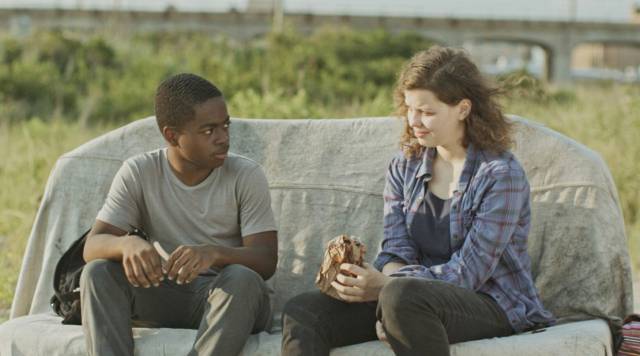
“But I mean, if you can only exist to hurt people, and you know better, then maybe it’s better to decide not to exist at all.”
The Transfiguration follows a troubled, impoverished orphan teen from the projects of New York City named Milo (Eric Ruffin) whose fascination with vampires has evolved into him actually believing he is one and hunting victims as a result. As he tries to navigate his tough life, he meets a new neighbor Sophie (Chloe Levine) with whom he can share the pain of his background and subsequently change his outlook.
The film is presented on its surface to be a vampire movie but in reality, it’s an examination of the lasting effect that trauma can have on those that have experienced it, and of the effect of abandonment, both familial and societal. Milo’s infatuation with consuming blood and death begins with his walking in on his mother’s corpse following her suicide and tasting the blood from her wrists. This traumatic experience and the resulting neglect of being left to raise himself, amidst little supervision from his older, war veteran brother Louis (Aaron Moten), and only his beloved vampire films and books to keep him company, leads Milo down the path of creating a fantasy in his head of being a vampire and eventually acting on said fantasy. Sophie’s attraction and gravitation toward Milo is also driven by the neglect she suffers from as an orphan and her experiences living in an abusive household with her grandfather. Both have sought refuge from the pain they’ve endured in their young lives but through disparate paths; Sophie by attempting to bond with someone with like experiences, and Milo by retreating into a dangerous fantasy world.
In the end, after bonding with Sophie and a discussion with Louis about how guilt for bad acts is a sliding scale, Milo become self-aware, choosing to pay penance for his acts while ensuring that Sophie finds the solace he feels that she deserves. The film’s conclusion raises an interesting question about the weight of guilt and the likelihood of changing who you are, or “transfiguration.” Milo felt he was irredeemable and could never change, and after realizing through Sophie that what he felt was his nature was wrong, he was better off leaving the world. Can a person who feels a compulsion to randomly take lives ever be fully rehabilitated? What if they’re as young as Milo and have been subjected to extreme trauma at an early age? Does their youth make them more likely to be able to change or is their behavior more set in stone? The film leaves these questions for us to debate, which helps make it more impactful and interesting to discuss.
Writer/director Michael O’Shea, making his directorial debut, does a great job of building tension and dread through the body language of the characters, MIlo in particular. It is very unsettling how he stares at and seemingly sizes up the people he encounters, especially when looking at their necks. The audience is left to wonder if he’s going to make any sudden movement or lunge at the person who he’s encountering, making them his next victim. It is also notable that O’Shea wrote and cast the film with a black lead in a black neighborhood without leaning heavily on any racial tropes or stereotypes. Milo’s blackness and that of his neighborhood weren’t sticking points and the film could’ve just as easily been about a young white boy. And despite race being inconsequential, it also wasn’t ignored to the point where the viewer is taken out of the film due to the black characters ending up in situations they never realistically would due to America’s racial realities. It’s a hard balancing act to pull off and many white directors don’t even try, particularly their first time behind the camera.
The film features notable cinematography, featuring picturesque color and scenery along with some great shots. One favorite of director of photography Sung Rae Cho is the extreme wide shot with the characters lingering in the background amidst their surroundings, simply blending in. It adds a real cinematic artistry to the film, almost like paintings, where the viewer is forced to soak in everything and not just focus on two figures engaging in dialogue.
Eric Ruffin and Chloe Levine ably carry this film as the two lead actors, presenting a believable love story that builds slowly and convincingly playing two kids with rough backgrounds in need of someone to lean on and bond with. The amount of screen time their characters are given required both to be at the top of their games in order to make the film work and they performed ably.
The Transfiguration is another entry into this era of horror that subverts the gore and monstrosity’s in favor of the exploration of real world issues. Delving into the struggles of abandoned and forgotten impoverished children through vampirism was a bold choice that Michael O’Shea deserves kudos for both attempting and successfully executing, particularly as a debut project. Lovers of cinema, and horror specifically, should give The Transfiguration the viewing it deserves.
Image: Transfiguration Productions

